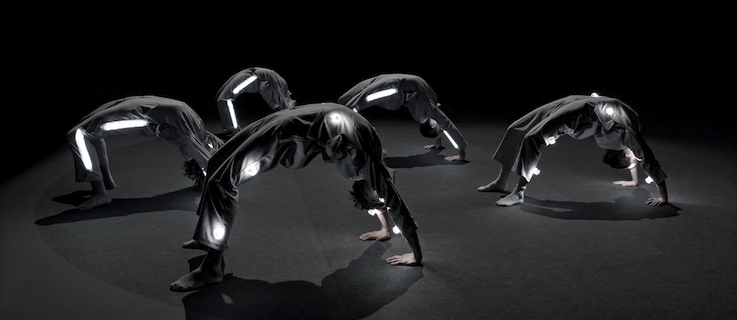Artificial Intelligence
Coding Art

If you think art and robotics have nothing in common, think again. Artificial intelligence is a tool for creative minds, and increasingly their competition. The digital revolution also provides art with plenty of fodder for critical reflection.
An algorithm on trial for murder: In her performance piece and subsequent film, The Trial of Superdebthunterbot, London artist Helen Knowles explores whether a computer code programmed to make autonomous decisions can be held culpable for any fatal errors it makes – here the death of two students killed in medical experiments. Knowles’ piece is part of the Open Codes exhibition at the Centre for Art and Media Karlsruhe (ZKM). The show explores life in the digital world and the relationship between code and art and is on display until August 2018.
Algorithms are making inroads into all areas of our lives. They calculate who is creditworthy, automate war, provide early diagnoses for disease or – like IBM’s Watson software – independently edit horror film trailers. And they are stirring up the world of art, as artificial intelligence (AI) cis changing creative perspectives and processes, and even transforming robots and software into artists. In a process known as deep learning, AI software can come to recognize patterns and, similar to the human brain, learn from experience to increase its ability to make automated decisions.
Algorithms are like musical instruments
The Google Brain “Google Magenta” research project in an experiment in artificially generated creativity. The Brain team is working on algorithms that produce music, video material, and visual art. Applications are published on the “TensorFlow” open-source platform to allow other artists and creative minds to drive development forward. One program, “Performance RNN”, composes music, and while Google Magenta admits that, “the performances generated by the model lack the overall coherence that one might expect from a piano composition”, the artificially generated characteristics and phrasings are still “impressive”.
Developers like British Professor of Computational Creativity Simon Colton have spent years building creative software. On its website, his invention, a robotic artist known as the “Painting Fool”, expresses its hope “to be taken seriously – one day – as a creative artist in my own right”. The software paints abstract pieces, which have gotten so good it is hard to tell human from machine. Colton also gave his “Painting Fool” the ability to recognize emotions, which allows it to use colour to reflect the subject’s mood in a portrait, for example.
 Für die „Sculpture Factory“ Series von Davide Quayola fertigen Industrieroboter von Michelangelo inspirierte Skulpturen an.
| © Davide Quayola
Italian artist Davide Quayola employs algorithms to provide new perspectives on famous icons of the art world. The original Renaissance paintings that serve as raw material for his colourful, abstract paintings are hardly recognizable in the finished pieces. His Iconographies series was based on famous works of art from his homeland. He used AI software to remix the originals, abstracting and emphasising colours
Für die „Sculpture Factory“ Series von Davide Quayola fertigen Industrieroboter von Michelangelo inspirierte Skulpturen an.
| © Davide Quayola
Italian artist Davide Quayola employs algorithms to provide new perspectives on famous icons of the art world. The original Renaissance paintings that serve as raw material for his colourful, abstract paintings are hardly recognizable in the finished pieces. His Iconographies series was based on famous works of art from his homeland. He used AI software to remix the originals, abstracting and emphasising colours
and details. “Misuse of technology is interesting for discovering new things,” Quayola says, adding that while the software replaces him, it does not replace the artist, and merely changes the artist’s role. He views algorithms as “musical instruments” for him to play with.
Technology is also changing processes of art production and digital art is no longer necessarily a solo endeavour. Artists often work with developers, and software and robots can also be valuable team members. In Quayola’s Sculpture Factory series, industrial robots create sculptures inspired by Michelangelo in real time in the art gallery. So generating
art becomes part of the installation itself.
Darknet shopping spree
Many young conceptual artists highlight and problematize increasing automation, big data and artificial intelligence in their work, exploring digitalization through socially critical art.
One art project provided a bot with 100 dollars in Bitcoin to fund a weekly shopping tour on Darknet market places like Agora and Alpha Bay. Some of the bot’s randomly selected purchases included a Coca Cola machine hacking tutorial, ecstasy tablets, and fake trainers, all of which were sent directly to a Swiss art gallery. The !Mediengruppe Bitnik from Zurich and London programmed the Random Darknet Shopper which, like Helen Knowles’ fictive trial that hints at the algorithmic abyss, explores questions such as who is responsible when software breaks the law.
The !Mediengruppe Bitnik also made art out of the fake profiles found among the data of millions Ashley Madison extramarital affair website users, released by hackers at the end of 2015. Since many more men registered on the website than women, Ashley Madison had created fake profiles, then programmed female chatbots to converse and flirt with users. The media group artists transformed this data and digital misuse into art, recreating these fembots in the Is anyone home lol exhibit in Berlin in summer 2017. They appear as masked avatars on LCD screens hung at adult eye height, from where they continue their chatroom conversations with visitors to the exhibition.
Aside from the digital dystopias, algorithms can be quite cute and cuddly too. Los Angeles artist Channing Hansen uses software to calculate the material, texture and colours that goes into his woollen works. The information generated results in psychedelic, knitted wall hangings that are comfortingly analogue.








Comments
Comment